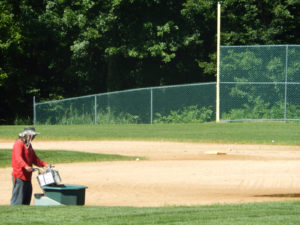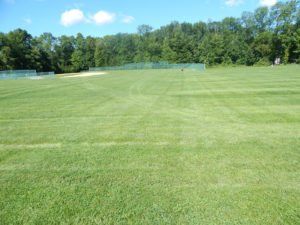Ridgedale Middle School Organic Turf Management
School and Municipal Turf Management Services
This is our third season providing an on-going turf management program. The turf had a severe ph issue at the onset, which resulted in thin growing grass and numerous bare spots throughout the entire turf areas. We treated this issue with the application of lime in the spring and fall season for optimum performance. The transition has been very good with the turf now having a dense full turf growth and a lush green color.
 Lime amendments come in various forms, from ground oyster shells to liquids. Agricultural-ground limestone is the preferred type because it is readily available, and you can apply easily, accurately, and safely using a drop or rotary spreader. There are two types of agricultural ground limestone: dolomitic and calcitic. Both contain calcium carbonate, a grass nutrient, and a neutralizer for acidic soil.
Lime amendments come in various forms, from ground oyster shells to liquids. Agricultural-ground limestone is the preferred type because it is readily available, and you can apply easily, accurately, and safely using a drop or rotary spreader. There are two types of agricultural ground limestone: dolomitic and calcitic. Both contain calcium carbonate, a grass nutrient, and a neutralizer for acidic soil.
Dolomitic Limestone: contains magnesium, another important nutrient, as well as calcium carbonate. Use if your soil is deficient in magnesium, however do not use if your soil is already high in magnesium as this will cause problems.
Calcitic Limestone: does not contain magnesium, making it more appropriate if your soil is already high in magnesium.
Too often, adjusting soil pH takes a back seat to other maintenance tasks that show more immediate results, such as fertilization and over-seeding. However, adjusting the pH of your soil is one of the most important maintenance practices in your turf-management program. If you ignore soil pH for too long, it may fall above or below the optimum range for turf growth. A soil pH that is too high or too low can result in inefficient use of fertilizer by turf, excess thatch buildup and increased pest problems.
Why is pH important? Soil pH affects turf health in several ways:
* Strongly acidic soils (below pH of 5.5) may result in calcium, magnesium and phosphorus deficiencies in some turf grass species and increase the availability of aluminum and manganese to levels that may be toxic. Soils with a high pH (greater than 8.5) tend to make phosphorus less available to plants. Also, iron chlorosis, an indication of iron deficiency, occurs more frequently on turf growing in high-pH soils.
 * Soil microorganisms aid in the breakdown of some nitrogen fertilizers and thatch. Soil pH in the range of 6.0 to 7.0 usually favors such microbial breakdown. However, most of these beneficial microbes do not thrive in strongly acid soils. Fertilizers that may be less effective or slower-acting in strongly acid soils include ureaform, sulfur-coated urea and natural organic sources.
* Soil microorganisms aid in the breakdown of some nitrogen fertilizers and thatch. Soil pH in the range of 6.0 to 7.0 usually favors such microbial breakdown. However, most of these beneficial microbes do not thrive in strongly acid soils. Fertilizers that may be less effective or slower-acting in strongly acid soils include ureaform, sulfur-coated urea and natural organic sources.
* Strongly acid soils create conditions that favor the growth of certain weed species. One of the most common and difficult-to-control weeds — moss — is more prevalent in acidic soils than in neutral or alkaline soils. Shepherds purse is another lawn weed that is a good indicator of acid soils.
* Soil pH influences some turf grass diseases. Although the reasons for this are not well-understood, one possibility is that strongly acidic soils reduce populations of microorganisms that suppress pathogenic fungi. Also, plants growing in strongly acidic soils may be more susceptible to disease because they suffer from nutrient deficiencies. Conversely, acidic soils suppress at least two turf grass diseases (take-all patch and Fusarium patch). Growing turf grasses within their optimum pH ranges does not prevent all turf grass disease, but it can reduce the severity of some infestations.
Lincoln Landscaping
THE NATURAL CHOICE
for ORGANIC School and Municipal Turf Management
Leave us a review on GOOGLE and tell us how we did……









